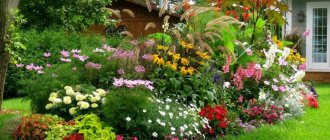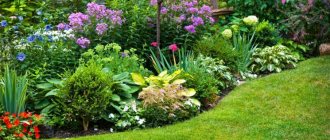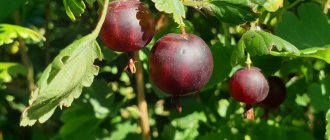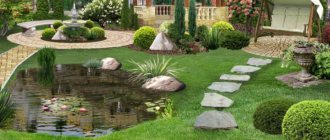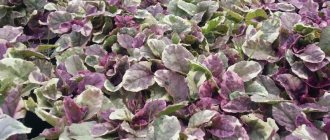Growing ornamental trees in our country has become a really popular activity. This is explained by the ease of planting such plants and the high level of their subsequent survival. Of course, the main advantage of such a tree is its beautiful appearance. That is why seedlings are increasingly being purchased by summer residents who want to decorate their own plot and create their own landscape park.
Ornamental trees, as well as their full-size counterparts, are also capable of protecting a person from the summer heat, creating a pleasant shade and giving the air a special freshness and pleasant aroma.
Deciduous
Everyone knows that deciduous trees are not only a wonderful decoration for gardens and streets, but also perform the most important function of purifying the air. That is why people have increasingly become puzzled by the cultivation of decorative species of deciduous trees in gardens and on their summer cottages.
Decorative varieties of such trees have a number of important advantages. The main one is rapid growth. After planting, you don’t have to wait several years to finally enjoy the look of a new grown tree. The leaves that fall from them in the fall are an excellent help for fertilizing the soil.
Dogwood
Thunberg barberry bush
Mahonia holly
boreal forests
The taiga is located south of the tundra and occupies 40 percent of the European part of the country, and also covers large areas of Siberia and the Russian Far East. Much of this region is permafrost. Although the taiga zone is predominantly composed of conifers, in some areas small-leaved trees such as birch, poplar, aspen and willow add diversity. In the extreme north-west of European Russia, the taiga is dominated by pine, although fir, birch and other trees are often found.
To the east, to the Western slope of the Urals, pine still grows, but fir already predominates, and in some areas there are almost pure birch forests. The flora of the taiga of the West Siberian Plain consists mainly of various types of pine, and birch dominates along the southern edge of the forest. Throughout most of the Central Siberian plateau and mountains of the Far Eastern region, the main forest-forming species is larch. The trees of the taiga zone are usually small and widely scattered. In some areas, where soils are poor in nutrients, there are no trees at all, and only marsh grasses and bushes form the vegetation cover.
Frost-resistant ornamental trees
In our country, one of the main difficulties in growing various fruit trees or other crops is low winter temperatures. This regime significantly reduces the number of trees that can survive in these conditions. However, frost-resistant ornamental trees can come to the rescue here, allowing you to enjoy their beauty all year round without much effort.
According to general rules, ornamental trees that show excellent survival at temperatures down to -15°C can be considered winter-hardy. However, some specimens are able to survive in extreme cold, down to -50°C.
Fluffy birch
Siberian (blood red) hawthorn
Red elderberry
Silver goof
Small-leaved linden
Types of ornamental trees and shrubs for the garden in the Urals
The climate in the Urals is considered quite harsh, but many plants and shrubs grow beautifully here. They can be used to implement any design style in landscape design. Among the conifers one can distinguish Siberian spruce, deciduous linden and willow, and among the shrubs Hungarian lilac and red elderberry. Let's take a closer look at each type.
Perennial ornamental trees and shrubs for the garden
Today, perennial plantings are becoming very popular, which can preserve the exclusive and unique image of the garden for many years. They are often used to create interesting compositions, create a special atmosphere and saving shade during the heat. Among the ornamental coniferous trees for the garden, Siberian larch, prickly spruce, Siberian fir, and Scots pine are known. Deciduous species include red rowan, silver maple, Canadian maple, bird cherry, linden, ash, chestnut.
Siberian larch
Spruce Blue Diamond
Siberian fir compact
Scots pine black cedar
Red rowan
Silver maple (sugar, hairy)
Canadian red maple
Bird cherry
Linden
Common ash Pendula
Common chestnut
Perennial flowering shrubs include viburnum . In the spring it decorates with its large white caps of flowers, and in the fall with red fruits. It is considered quite frost-resistant and grows unpretentiously in temperate climates. Many people like it because of its lush blooms and bright foliage.
Kalina Gordovina
When selecting perennial plantings, one cannot help but think of lilac . It is suitable for almost any garden and personal plot. Blends perfectly with flowering shrubs, such as jasmine . With its help you can breathe freshness into your landscape design.
Lilac
Jasmine
Considering perennials and ornamental shrubs for the garden, it is worth mentioning elderberry , which is quite popular in the middle zone. It has a fairly lush, thick curly crown and is famous for the pleasant aroma of flowers. It should be noted that elderberry can be in the form of a shrub and a tree.
Black elderberry Black Lace
Buddleia, which can reach a height of 1.6 meters, is also used as decoration It fascinates with its beauty, original color palette, spreading shape and luxurious clusters of flowers. It blooms from early spring to late autumn. It will add a special piquancy against the background of coniferous vegetation.
Buddleya David
Winter-hardy ornamental trees and shrubs for the garden
Among them are Canadian spruce and Engelmann spruce; one can also note white willow, small-leaved linden, rowan, and bird cherry. Most of them have a root system located at a depth of 45–85 cm, so they are not afraid of frost. They belong to the frost-resistant category and grow even in places where the temperature drops to -35 degrees. However, the most frost-resistant are Siberian spruce, downy birch, juniper, cedar and Siberian pine. They have a fairly powerful root system that can withstand temperatures down to -50 degrees.
Canadian spruce
Engelman spruce
White silky willow
Small-leaved linden (heart-shaped)
Siberian spruce
Juniper
Mountain pine Pumilio
Among the shrubs are serviceberry, viburnum, Tatarian honeysuckle and common hawthorn. These plantings usually grow without any problems. They are able to withstand temperatures down to -28...-33 degrees. Shrubs can have a wide variety of shapes and can be used as hedges, alleys, or to decorate the landscape.
Irga Lamarca
Kalina Buldenezh
Tatarian honeysuckle
Common hawthorn
Mountain pine, yellow acacia, and Siberian dogwood are also suitable for the Urals Derain is considered the most frost-resistant and unpretentious ornamental shrub for the garden. Its features include a brightly colored red trunk and large green leaves.
Yellow acacia
White Siberian dogwood
Spirea can also be classified as frost-resistant which grows well in places where the temperature ranges from +40 to -40 degrees. Its distinctive features include long flowering and original shape. Depending on the variety, it can have a height from 0.6 to 1.9 meters. Their advantage is that they do not need shelter even in the harsh Siberian winters. They have a variety of colors at different times of the year. They harmonize perfectly with hostas and junipers.
Spiraea gray Grefsheim
Hosts
Among the frost-resistant ornamental shrubs for the garden, snowberry is also known. It calmly endures even the coldest winters, when the temperature drops to -45 degrees. The shrub is unpretentious, can grow both in the shade and in open sun, is not susceptible to diseases and pests, and usually reaches a height of 1.4–1.6 meters. It requires minimal care. It is often used as a hedge or for zoning various areas. Looks especially good against the background of conifers.
Snowberry
Shade-tolerant ornamental shrubs for the garden
Picturesque plantings are used not only for decoration, but also to effectively fill space. Their advantages include the fact that they grow well even in places with poor lighting. Among them, the first place is occupied by the euonymus. It grows well in places of low light, pleasing to the eye with its openwork crown and rich colors. The maximum height of the shrub can reach 1.8 meters, the foliage is mosaic, the crown is transparent. An important condition for its growth is shading and fertile soil. Euonymus is often used to fill the space under large trees.
Euonymus
occupies a leading position among shade-loving shrubs . It is perfect for growing in the Urals, where the climate is sharply continental. There are different types of mahonia, for example creeping, holly. Each type looks quite original; they are used to form a spectacular evergreen background under large massive trees.
Mahonia holly
can also be classified as shade-tolerant . Gardeners value it for its beautiful large inflorescences in bright purple and pink shades. The foliage has an original oval shape. It is often planted along the perimeter of a residential building or next to a fence.
Rhododendron
In the middle zone, mock orange and viburnum leaf are also used. Mock orange is famous for its delicate aroma, unpretentiousness, and can be placed in places with poor lighting and deep shade. Breeders offer various types of this planting. The bladderwort has the best decorative properties, a dense spherical shape, lush clusters of flowers.
Chubushnik
Bladderwort viburnum
also adapts perfectly to partial shade and dense shade . Its only drawback is that it needs protection for the winter. Wintergreen can be classified as frost-resistant . It looks quite beautiful and neat. Bright red fruits give the landscape its own special zest.
Wintergreen recumbent
Tall ornamental trees for the garden
There is a wide variety of tall ornamental plantings. When choosing, you should take into account the functional purpose, features of the residential building, area of the territory, and the presence of buildings. For a small garden, choose large trees with rounded crowns. , oak, ash look great on a small privet, palm-shaped maple. When selecting, it is important to take into account winter hardiness and the ability to withstand harsh winters.
Oak
Privet
palm maple
Among the favorites of tall trees is the weeping birch. This beauty can reach a height of 7.5 meters. The advantages of birch include weightlessness, romantic charm and poetry. Classic linden is also quite large in size and is often used for alleys and large areas. Particularly popular is the unusual round-leaved rowan, reaching a height of 13.5–15.5 meters.
Young's Weeping Birch
Rowan aria (round-leaved, mealy)
Low shrubs and ornamental trees for the garden
Originally designed green plantings are often used to transform the landscape. Small decorative trees for the garden look quite exclusive and sophisticated in appearance. With their help, you can create original compositions that can decorate your garden all year round. When selecting a suitable planting, it is necessary to take into account the requirements for soil, temperature conditions, indicators of adaptation to climate and compatibility. It is recommended to first draw up a site plan, and only then establish planting sites.
Among the deciduous dwarf ornamental trees for the garden, fan maple atropurpureum can be distinguished. It is usually grown as a vertical planting. It goes well with a variety of plantings. It can reach a height of 3.5 meters.
Fan maple Atropurpureum
Swamp oak is most often used in single plantings. Its crown has a spherical crown. The leaves are green in summer and reddish-orange in autumn. It is also important to note common ash. Its peculiarity is that the crown has unevenly growing thick branches, densely covered with foliage.
Swamp Oak Green Dwarf
Among the coniferous low ornamental trees for the garden, push spruce and spruce nediformis are known. Push spruce has an original bright green color; it reaches a height of 35–45 cm. Oval buds of orange-brown color are formed at the ends of the shoots. Spruce nediformis is considered quite frost-resistant. Suitable for the Urals. Its design resembles a bird's nest. At the initial stage, the needles have a light green tint, which darkens over time. The presented low-growing ornamental shrub for the garden can be used to decorate recreation areas and arrange alleys.
Spruce Push
Spruce cushion Nidiformis
For a sharply continental climate, mountain Jacobsen pine would be an excellent option. It can withstand temperatures down to -35 degrees. A fairly neat crown and long needles make the tree very beautiful, resembling a fluffy pompom in appearance.
Mountain pine Jacobsen
The Little Jam spruce belongs to the category of dwarf plantings Its height is usually between 30–40 cm. A special feature of the planting is the complete absence of cones. It is considered the best option for decorating gazebos, terraces, front entrances, and rockeries. The evergreen plant pairs well with flowering perennials and beautiful brightly colorful roses.
Norway spruce Little Gem
Fast-growing ornamental trees and shrubs for the garden
The fastest growing ones include silver maple, bird cherry and white willow. grows very quickly . Pyramid-shaped compositions look especially impressive. The red maple also looks beautiful . Additionally, it should be noted that birch grows up to 2 meters in height in one year. Curly and silver birch are popular The best option for landscaping small recreation areas.
Poplar pyramidal
Red maples
Silver birch
Among fast-growing coniferous trees for garden decoration, we can distinguish European larch or oriental spruce. Larch belongs to the category of winter-hardy and durable plantings. There are various options for decorative coniferous species. Many people like the fact that in the spring it has a light green color, and in the fall it has a golden yellow hue. Spruce is attractive because it has a light green tint throughout the year and takes root well in moist and acidic soils and in well-lit places.
European larch Repens
Eastern spruce
is a fast-growing shrub . It grows quite quickly in the first months after planting. also quickly reaches height . Grows up to 2 meters in height in 3–4 years. Golden currant reaches 60 cm in one year. Tree hydrangea grows 45–65 cm during the year, 35 cm in the middle zone. It is important to note one of the unpretentious plantings - dogwood. The shrub can grow quite quickly up to 2 meters in height. However, for this he will need enough space.
Fieldfare Pink Hopi
Golden currant
Hydrangea
Cotoneaster horizontal
The considered ornamental trees and shrubs will be an excellent decoration for a suburban area. Many of them grow quite quickly, do not require special care, and are suitable for a sharply continental climate.
There are special catalogs where you can find the names and photos of ornamental trees and shrubs for the garden. Thanks to them, you can choose the most optimal option for yourself. First you will only need to become familiar with the features of a particular planting so that it has an attractive appearance for a long time.
Important recommendations when choosing a landing
- Climate. If you are choosing a plant for a garden in the middle zone, where temperatures can drop to -45 degrees, be sure to take this into account. Decorative flowering shrubs for the garden must withstand low temperatures and are frost-resistant.
- Soil type. The most common are sandstone, clayey and wetlands. Clay soil is best suited; it is more fertile and retains moisture and nutrients well. Sandy soil has its own criteria, since in winter the soil freezes quite quickly.
- Object size. When choosing a suitable crop, you should take into account the size of the plot. For example, magnolia can be placed up to 2.5–4 meters wide.
Additionally, you need to take into account the degree of illumination, because some crops love the sun, while others love more shaded areas.
If you don’t know what ornamental tree or shrub to plant in the garden so that it feels great in the Ural weather, contact the specialists of the Terra Dom company. Designers in the field of landscape design will select suitable decorative compositions not only taking into account the design, but also climate, soil and other parameters. The correct selection of plantings will provide them with a long lifespan and allow you to enjoy their pristine beauty for many years. By combining different types and varieties of plantings, you can create a luxurious garden where every minute will bring the most pleasant emotions.
Create a beautiful landscape to receive aesthetic pleasure from your site and natural protection from the summer heat.
Soapberry
A useful plant that bears fruit at the end of November. Sapindus Drummond produces green drupes with a soft surface. Next, the upper part of the fruit begins to harden and then turns into a real nut. The tree got its name due to the fact that the pulp is capable of forming foam when it comes into contact with water.
Nuts have long been used as a natural cleanser. They have antiseptic, antibacterial, anti-inflammatory and other properties. The tree can be grown at home because it is low maintenance.
handkerchief tree
Grows in Yalta and Sochi. It was brought to Russia by the French monk J. David in 1929. However, the handkerchief tree has not become widespread due to its difficult reproduction. The plant got its name from its unusual appearance. During the flowering period, white inflorescences of large shape, reminiscent of napkins, appear on it.
In 2016, we managed to obtain a viable sprout. Therefore, now in the Southern Cultures park, which is located in Sochi, a young plant grows next to the main tree.
Liriodendron
A tulip tree that appeared in Yalta in 1813. Raevsky brought the seedling and planted it in the village of Golovinka. Today the height of this tree is more than 32 meters, the diameter of the trunk is still fixed at around three meters. Externally, lyriodendron resembles an oak tree from a fairy tale by Alexander Sergeevich Pushkin.
The tulip tree has fruits that resemble a fir cone. They ripen in August. The tree got its name because of its flowers. They densely cover the plant, have a yellowish tint and the appearance of a tulip.

